When I went to the Fred Hall show earlier this year, I had the opportunity to chat at length with Darin Dohi, General Manager of Seeker Rods. Darin showed me some rods and I was really taken with the new Inshore Pro series that is the latest iteration of Corey Sanden (of MC Swimbaits) endorsed near shore fishing tools. The new rods are lighter than the previous Blue Lightning series, yet strong enough to handle a yellowtail or seabass should your offering find a bigger target along the kelp line. Darin invited me out to visit their factory in Long Beach to learn more and recently I had the opportunity to do so.
History
We started in Darin’s office where he gave me some background on the company. Seeker started in 1989, arising from the ashes of what was once the California Tackle Company that produced the original Sabre Rods (Seeker still has both the patterns and equipment used to produce the original Sabre Rods). When California Tackle Co. was bought, and production taken overseas, Wade Cunningham purchased the old equipment and started Seeker (interestingly, Leon Todd, formerly of California Tackle, started what would become Calstar at the same time). Cunningham was formerly a rod designer for Fenwick Rods when they were based in Westminster, CA. He ran the company until Seeker was acquired by Parrish Enterprises in 1993 and Joseph Pfister took over the company. The focus of the company was to produce rods for our local fishery…live bait and jig fishing. The rods they produced were parabolic, easy on the angler, but had a reputation for lacking power.
In 1997, Randy Penny joined Seeker and his first order of business was to fix this negative rap on the Seeker name. At the time, Calstar was dominating the long range scene. Randy set about to change things and his initial focus was to redesign the Black Steel line of rods. What Randy came up with was a graphite and E-Glass composite rod. It is a multi-stage blank where the graphite is layered onto the bottom end of the rod, stiffening the bottom half of the blank, then giving way mid-rod to the glass. The result was a fast tipped rod that could throw bait, but shut off quicker to provide the power required to battle tuna. His design was a success. One of the first fans of Randy’s new design was legendary captain of the Red Rooster III, John Grabowski. A working relationship followed. Capt. Grabowski gave product input. Randy incorporated that input into his designs. Capt. Grabowski used the rods on the boat, as well as in the many long range seminars he used to do. One of the first rods resulting from this collaboration is the now famous 6470 blank that is a mainstay still today (Editor’s note – the Black Steel 6470 is my “in case things get stupid rod”).
Randy followed the success of the Black Steel redesign with the creation of the Super Seeker line. The Super Seeker was unique in that it was the first full lineup of rods produced by Seeker combining S-Glass and graphite to create a rod of tremendous strength, and durability. The Super Seeker was purpose built to withstand the rigor of the standup style of tuna (and other big game species) fishing we do here and further cemented Seeker’s presence as one of the major players in fishing rods on the long range scene.
S-Glass vs. E-Glass
Darin and I had been talking for about 45 minutes. He needed to take a call, so I made my way downstairs to meet Randy. Randy is the Chief Designer and Production Manager for Seeker. “Darin manages everything upstairs, and I manage everything downstairs.” Gotcha. We picked up the conversation about the Super Seekers.
“S-Glass is actually a military specification (mil spec) material used in various applications by our armed forces. It’s both a stronger fiber than the one used in E-glass, and the weave of the fibers is different as well.” Randy explained that in the E-glass weave, the fibers cross at a 90 degree angle. In S-glass, the angle is less severe, creating more strength and recoil along the length of the rod. “A lot of people don’t realize that S-Glass is just as expensive as graphite. True S-glass is made in the U.S. and cannot be exported.”
Randy took me to the cutting table area where the process starts. “As a designer, I have different levers I can pull to achieve certain actions. One is the materials I use. S-glass is very strong and has a parabolic bend. Graphite is stiffer. Another thing I can do to affect the action is the taper of the rod.”
Taper vs. Action
Randy educated me on the difference. Although some people use these terms interchangeably, taper actually refers to the physical dimension of how fast the rod tapers down in circumference from the butt to the tip. Action refers to the characteristics of the bend of a rod under stress. A fast taper can lead to a fast action, but it’s not the only factor…materials used and how they are employed are the other considerations.
The Process
We moved from the cutting table to the machine where they do the tacking of the cutout pieces to the mandrel (the solid metal core used in the build process). From there, the piece is rolled onto the mandrel with another machine. Once the rolling is completed, the future rod proceeds on to the taping machine. The taping machine uses two kinds of tape to cover the entire rod. This outer covering creates the outer mold (the mandrel is the inner part) for the unfinished rod. After taping, the rod is ready to be heated up in order to combine the individual cutout pieces, into the actual blank that is the basis of the rod.
- Fiberglass rolls
- Tacking cut pieces onto mandrel
- Rolling process
- Taping to form outer mold
In the next installment, we’ll see how the rods are finished, and talk about the future of Seeker Rods.

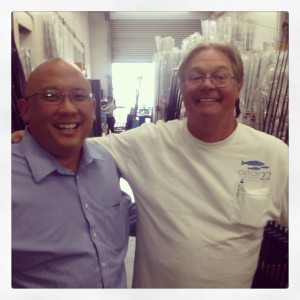
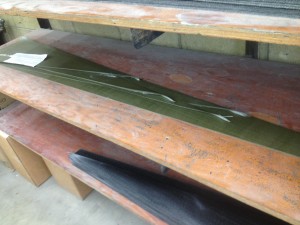




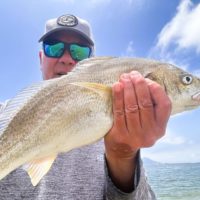
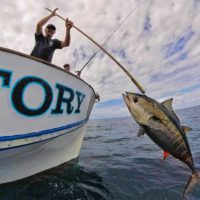
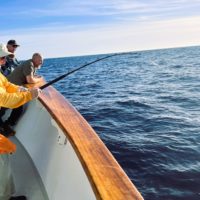


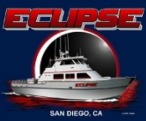


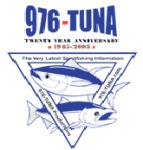
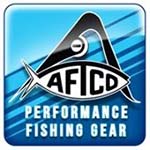
No Comments